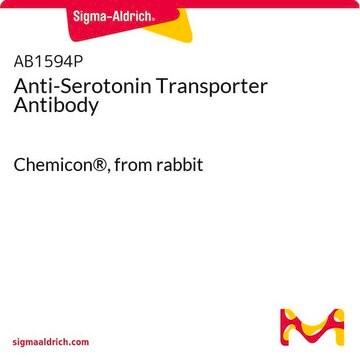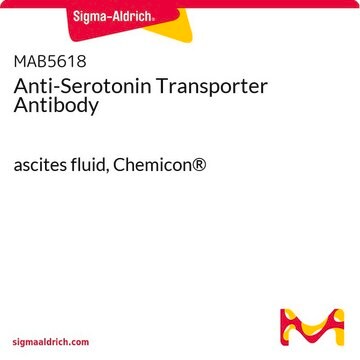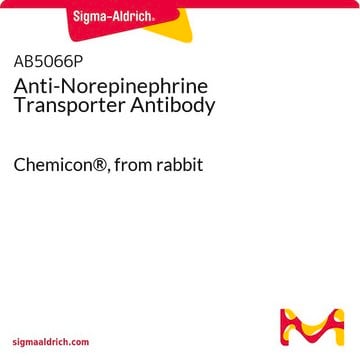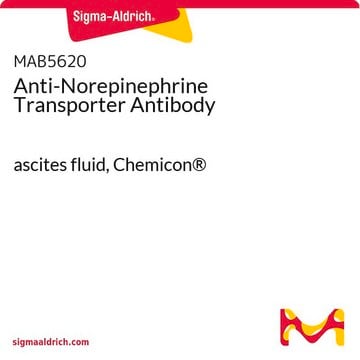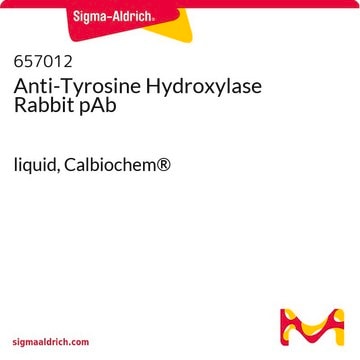MAB1564
Anti-Serotonin Transporter Antibody, clone 17-7A4
clone 17-7A4, Chemicon®, from mouse
Sign Into View Organizational & Contract Pricing
All Photos(1)
About This Item
UNSPSC Code:
12352203
eCl@ss:
32160702
NACRES:
NA.41
Recommended Products
biological source
mouse
Quality Level
antibody form
purified immunoglobulin
antibody product type
primary antibodies
clone
17-7A4, monoclonal
species reactivity
rat
manufacturer/tradename
Chemicon®
technique(s)
immunohistochemistry: suitable
isotype
IgG1
shipped in
wet ice
target post-translational modification
unmodified
Gene Information
human ... HTT(3064) , SLC6A4(6532)
Specificity
Recognizes Serotonin Transporter.
Immunogen
Rat serotonin transporter, N-terminus/GST fusion protein (aa 1-85).
Application
Detect Serotonin Transporter using this Anti-Serotonin Transporter Antibody, clone 17-7A4 validated for use in IH.
Immunohistochemistry: 0.5-1.0 μg/mL on paraformaldehyde fixed brain and adrenal tissue. Has not been tested on paraffin embedded tissue. Not recommended for use in Western blotting. Optimal working dilutions must be determined by end user.
Research Category
Neuroscience
Neuroscience
Research Sub Category
Neurotransmitters & Receptors
Neuronal & Glial Markers
Neurotransmitters & Receptors
Neuronal & Glial Markers
Physical form
Format: Purified
Protein A Purified mouse immunoglobulin in 20 mM sodium phosphate, 250 mM NaCl, pH. 7.6, with 0.1% sodium azide as a preservative.
Protein A purified
Storage and Stability
Maintain for 1 year at 2–8°C from date of shipment. Aliquot to avoid repeated freezing and thawing. For maximum recovery of product, centrifuge the original vial after thawing and prior to removing the cap.
Analysis Note
Control
Brain tissue
Brain tissue
Other Notes
Concentration: Please refer to the Certificate of Analysis for the lot-specific concentration.
Legal Information
CHEMICON is a registered trademark of Merck KGaA, Darmstadt, Germany
Disclaimer
Unless otherwise stated in our catalog or other company documentation accompanying the product(s), our products are intended for research use only and are not to be used for any other purpose, which includes but is not limited to, unauthorized commercial uses, in vitro diagnostic uses, ex vivo or in vivo therapeutic uses or any type of consumption or application to humans or animals.
Not finding the right product?
Try our Product Selector Tool.
Storage Class Code
10 - Combustible liquids
WGK
WGK 2
Flash Point(F)
Not applicable
Flash Point(C)
Not applicable
Certificates of Analysis (COA)
Search for Certificates of Analysis (COA) by entering the products Lot/Batch Number. Lot and Batch Numbers can be found on a product’s label following the words ‘Lot’ or ‘Batch’.
Already Own This Product?
Find documentation for the products that you have recently purchased in the Document Library.
A L Halberstadt et al.
Neuroscience, 147(1), 207-223 (2007-05-18)
It is well known that the dorsal raphe nucleus (DRN) sends serotonergic and nonserotonergic projections to target regions in the brain stem and forebrain, including the vestibular nuclei. Although retrograde tracing studies have reported consistently that there are differences in
Patrick Aldrin-Kirk et al.
Neuron, 90(5), 955-968 (2016-05-11)
Transplantation of DA neurons is actively pursued as a restorative therapy in Parkinson's disease (PD). Pioneering clinical trials using transplants of fetal DA neuroblasts have given promising results, although a number of patients have developed graft-induced dyskinesias (GIDs), and the
Jyh-Jeen Yang et al.
Scientific reports, 7(1), 640-640 (2017-04-06)
The suprachiasmatic nucleus (SCN) central clock comprises two coupled oscillators, with light entraining the retinorecipient vasoactive intestinal peptide (VIP)-positive ventrolateral oscillator, which then entrains the arginine vasopressin (AVP)-positive dorsomedial oscillator. While glucose availability is known to alter photic entrainment, it
Tanya L Daigle et al.
Cell, 174(2), 465-480 (2018-07-17)
Modern genetic approaches are powerful in providing access to diverse cell types in the brain and facilitating the study of their function. Here, we report a large set of driver and reporter transgenic mouse lines, including 23 new driver lines
Pi-Cheng Cheng et al.
Scientific reports, 9(1), 6430-6430 (2019-04-25)
The central clock in the suprachiasmatic nucleus (SCN) has higher metabolic activity than extra-SCN areas in the anterior hypothalamus. Here we investigated whether the Na+/H+ exchanger (NHE) may regulate extracellular pH (pHe), intracellular pH (pHi) and [Ca2+]i in the SCN.
Our team of scientists has experience in all areas of research including Life Science, Material Science, Chemical Synthesis, Chromatography, Analytical and many others.
Contact Technical Service
